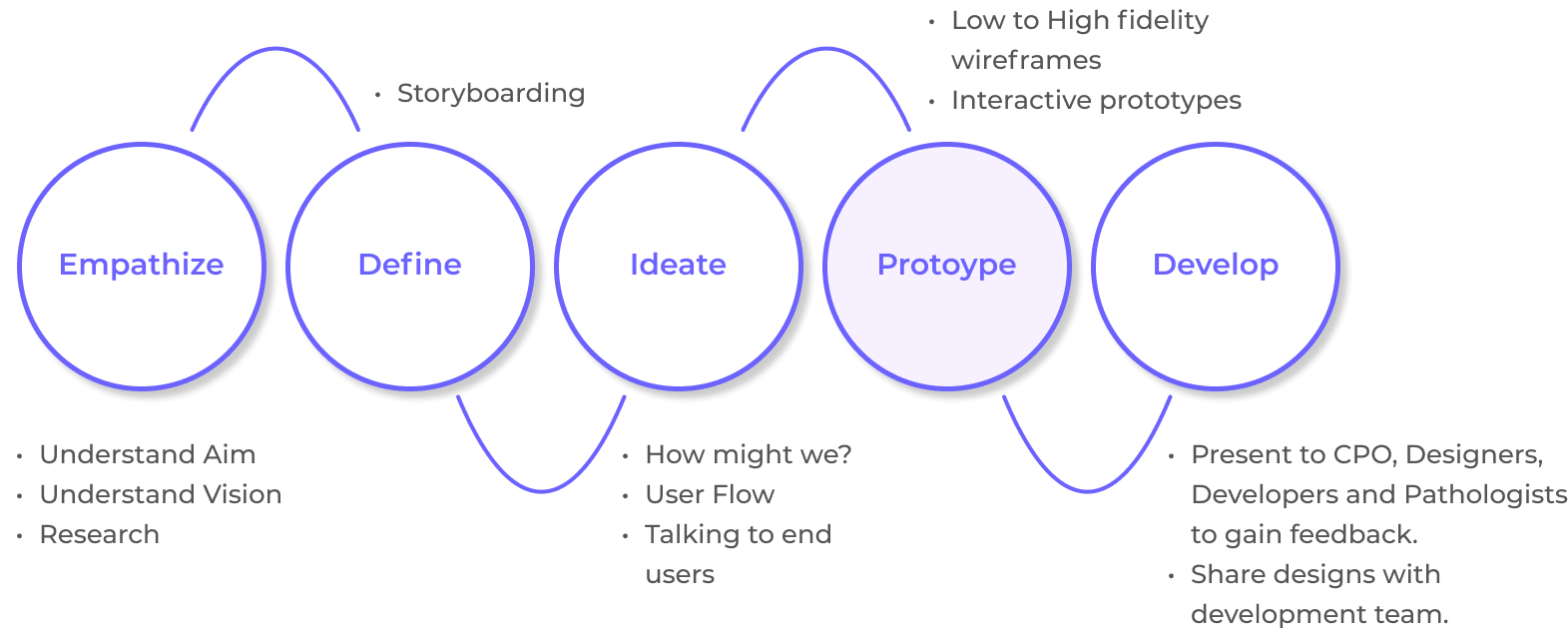Digital Pathology
Service Platform Redesign for Archival Scanning
The service platform enables pathologists to access and diagnose patient cases from anywhere in the world, facilitating timely and accurate diagnoses. The redesign ensures consistent delivery of reliable results, reducing the risk of errors and minimizing the need for manual intervention by digitizing Archival slides, possessing the potential to metamorphose into substantial knowledge, hold the key to driving advancements in diagnostics and personalized medicine, revolutionizing patient care in the days to come.
Summary
Redesigning a Pathology service platform workflow that not only helps streamline and accelerate the diagnostic process, but also enhances patient care by providing pathologists with reliable and precise information for making critical decisions.
Designed custom dashboards for Pathologists to improve user experience and foster a clinical environment that fully integrates multimodality in pathology by automating workflows, enabling pathologists to analyze and interpret digital pathology images with unparalleled accuracy and efficiency.
Role
UI/UX, Ideation, Storyboarding, Prototyping, Wireframing, Interaction Design
Tools
Figma, Miro, Zeplin, Fig Jam
Timeline
Internship Full time, 7 months
Team
Product Leads, Developers, Resident Pathologist, UX Designer
Scope of the Problem
Pathologists play a fundamental role in diagnosing diseases and providing essential insights into patient care. With the introduction of digital pathology, the conversion of physical glass slides into high-resolution digital images offers numerous benefits, including remote access, collaborative analysis, and improved storage and sharing capabilities. However, the design of an efficient and user-friendly service platform and dashboards becomes paramount to facilitate this transition effectively.
Challenges
1. Data Accessibility: Pathologists require easy access to digitized archival slides from anywhere, at any time. The platform should allow pathologists to upload, store, retrieve, and share digital slides seamlessly.
2. Intuitive Navigation: Effective user interfaces should provide clear and intuitive navigation, allowing pathologists to quickly locate specific slides. Implementing a search functionality, filters, and sorting options would enable efficient slide retrieval.
3. Annotation and Marking: Pathologists heavily rely on annotations and markings on physical slides for making diagnoses. Designing an interface that allows annotations on digital slides, ensuring easy editing and review, is crucial for maintaining accuracy and reducing time constraints.
4. Collaborative Environment: A platform that fosters collaboration among pathology teams is essential. The design must allow pathologists to share slides, annotations, and expert opinions to aid in diagnosis and research.
5. Automation and Integration: Designing an interface that seamlessly integrates with existing laboratory information systems, scanners, and image analysis software is crucial. Automation of slide digitization processes and data transfer from scanners to a unified dashboard would significantly enhance workflow efficiency.
Design Process
Target Users
Pathologist
Healthcare Institutions and Labs
Understanding the problem!
Problem 1: Manual Slide Archiving Process
One of the key challenges in pathology laboratories is the manual archiving of glass slides. Traditionally, pathologists have relied on physical storage systems, which tend to be cumbersome and prone to errors. These physical slides can be damaged, misplaced, or deteriorate over time, leading to potential loss of critical patient data. Retrieving specific slides for reference or review can be time-consuming and inefficient. There is a pressing need for a digital solution that simplifies the archiving and retrieval process.
Solution 1: Digital Pathology Archival Slides Service Platform
This platform leverages advanced imaging technology to scan and store the slides electronically. It offers a seamless, centralized repository for pathologists and laboratory staff to access and manage slides efficiently.
The utilization of digital format facilitates streamlined storage and prioritizes the latest archived slides, given the significance of digital images in recurring cases. This enhanced accessibility empowers pathologists to effortlessly retrieve previous case data and enables the practice of telepathology.
Problem 2: Inefficient Data Analysis and Collaboration
Pathology laboratories often face challenges in analyzing large volumes of data and collaborating effectively. Manual data analysis can be time-consuming and can lead to variations in interpretation. Furthermore, the lack of a centralized platform for collaboration limits the ability of pathologists to seek second opinions or receive expert advice easily.
Solution 2: Digital Pathology Dashboard
The integration of a digital pathology dashboard within a pathology laboratory's workflow can revolutionize data analysis and collaboration. By leveraging the z-stacking algorithm and computer-assisted diagnosis, the platform can provide rapid and accurate image analysis, aiding pathologists in their diagnostic interpretation.
Moreover, the digital pathology dashboard offers a collaborative environment where pathologists can securely share cases and seek second opinions from peers in real-time. This facilitates knowledge sharing, improves accuracy, and ensures consistency in diagnoses. The platform also allows for remote access, enabling pathologists to work from different locations, enhancing flexibility and efficiency.
Pathologist Dashboard Design
The pathologist dashboard design is a crucial tool in enabling pathologists to analyze and interpret medical data efficiently. While I cannot specifically showcase the actual design due to non-disclosure agreements (NDA), the dashboard encompasses a visually appealing and intuitive user interface. It incorporates advanced data visualization techniques that facilitate seamless navigation and interpretation of complex datasets. The design prioritizes user experience, ensuring that pathologists can easily access pertinent patient information, perform detailed analysis, and generate comprehensive reports. With a primary focus on efficiency, accuracy, and confidentiality, the pathologist dashboard design enhances diagnostic capabilities, and ultimately improves patient care.
My Cases
All Cases
Performance
Reports
Help
Outlining the fundamental set of KPIs and actionable tasks that necessitate the attention of pathologists.
A comprehensive report showcasing intricate details of each case, alongside the primary pathologists responsible for them. Pathologists possess the ability to organize, explore, and prioritize case diagnoses by status, using sorting and search functionalities to retrieve specific cases.
Digitizing Archival Slides
Pathology has played a critical role in disease diagnosis for centuries, resulting in the creation of hundreds of millions of glass slides. However, the true potential lies in digitizing these slides to unlock invaluable knowledge that could revolutionize diagnostics and personalized medicine for patients. To harness the power of digital and AI-enabled pathology, it is crucial to adopt a factory-based approach for digitizing large volumes of slides. This process will not only accelerate disease research, innovation, and education but also empower pathologists with advanced diagnostic capabilities. While the traditional pathologist learns from thousands of slides, digital pathology repositories allow them to learn from millions. To realize the full potential of pathology data, it is imperative to digitize the slides and their associated metadata. The design for this digital transformation is protected under a non-disclosure agreement, making the original design unavailable for display.
Reflections
Through this project, I gained valuable insights and experience that have shaped and strengthened my skills as a designer. Firstly, I learned the significance of thorough research and empathizing with the target audience. By conducting extensive research, I was able to identify their needs, desires, and pain points, ultimately delivering a more impactful design solution. Additionally, I learned the importance of collaboration and effective communication within a design team. Sharing ideas, receiving constructive criticism, and working together towards a shared vision enhanced the overall quality and creativity of the project. Lastly, I learned to embrace flexibility and adaptability in the face of challenges or unexpected changes. This project taught me that being open to new ideas and approaches leads to innovation and growth as a designer.








